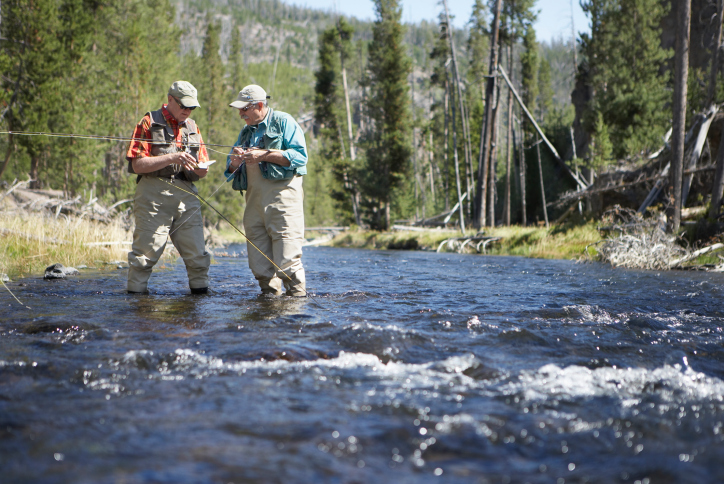
Stocking Your Boxes with the Right Flies Assures You’ll Catch More Trout in the Coming Season
Our annual spring inventory of fresh fly-fishing flies just arrived at Tri-State Outfitters in Lewiston, Idaho. While I set to restocking depleted bins I couldn’t help but contemplate my own fly boxes. There are plenty of empty spaces in those “fly bins” as well; flies sacrificed to submerged structure and overhead branches the previous season. In all likelihood your own fly boxes are in real need of replacements as well.
One of the most common questions Greg Cunha and I field from fly-fishing customers while manning the fishing department in Lewiston is, “Which flies will I need?”
I compartmentalize each upcoming fly-fishing season according to what water conditions and temperatures dictate, and the fly types these conditions demand. This includes Early Spring, Late Spring, Early Summer and Late Summer into Early Fall.
Early Beginnings
Early Spring (cold water, pre-runoff, early to late April into May, depending on altitude and location) indicates deep-water nymphing. This is split-shot/strike-indicator stuff with nymphs riding just above or tapping bottom. Nothing really technical to report here. Stick with the basics, such as Gold-Ribbed Hare’s Ears (natural and olive), Zug-Bugs, Prince Nymphs or Pheasant Tail Nymphs in #8 to #12, just as examples. Bead head versions save adding more split shot in deeper water. You’ll also want some stonefly nymphs; basic Montana Nymphs, Bitch Creeks or Softshell Stones in sizes 6 to 4. You’re gonna lose some flies to the bottom, so buy accordingly.
During Early Spring, if you hold aspirations of possible dry-fly action, it will most likely involve Blue-Winged Olives, a.k.a. BWO (sizes 24 to 18) or midges (Griffin’s Gnats, sizes 24 to 20). If you’re impatient for a top-water fix, arrive prepared…
Ladies and Gentlemen, Start Your Engines
Late Spring (May through June) is when trout wake up and really begin to gorge. One aspect of fly fishing many anglers seem to neglect is big streamers (tossed with 6- or 7-weight rods). This is a great time to catch big trout, and big trout eat big flies. My old-time favorites are Woolly Buggers in all hues and configurations. Bead and Cone Heads get these flies down deeper and add some sparkle. Stock up on black, olive and browns, in sizes 4 through 8 and you’re guaranteed to catch some fish. It’s also a good idea to stock some sculpin and general baitfish patterns; crawfish if your local waters hold them. Note: Woolly Buggers make good crawdad imitations).
Late Spring also brings the first of the season’s exciting hatches. Large among these is the salmonfly or stonefly fall. Finding yourself in the middle of a salmonfly hatch without proper patterns will bring tears to your eyes. You may not hit it just right, but if you do and are unprepared you’ll never forgive yourself. Orange X Stimulators, Rogue River Salmonfly and Henry’s Fork Salmonfly (in sizes 4 to 6) are some of my favorites.
Other Late Spring dry-fly events (at least in North Idaho) include Pale Evening Duns, spring caddis and occasional Skwalla stoneflies. These means Ginger Quills or Light Cahills (#12 or #14), Tan, Olive or Grey Elk Hair or X-Caddis (#16 to #12) and Olive Stimulators or True Skwalla Winged Stonefly patterns (#8 to #6). Then there is the do-it-all Adams (#10 through #16), which always seems to work in a pinch for most mayfly hatches. Don’t leave home without them.
Chasing Hatches
Early Summer (June into July) is a fine time to be a fly fisherman; granted your local river isn’t flooded by runoff. This can include some of the season’s hottest dry-fly fishing. Matching the hatch can certainly come into play, but as often “searching” patterns fill the bill (especially on less educated trout). Don’t wring your hands regarding the hatch-matching dodge. These are Rocky Mountain trout, not those found in English chalk streams. You can cover 98 percent of your needs by stocking Light Cahills (light hue), Adams (medium hue) and Dark Hendrickson (dark hue) in sizes 12 through 16. Otherwise, Orange and Royal Stimulators (size 8 through 14), Royal Wulffs, Red and Yellow Humpies, H&L Variants (one of my personal favorites) and similar patterns in sizes 10 through 16 do the trick.
Hawg-Days of Summer
With the onset of honest-to-goodness, steamy-hot Late Summer (Late July through September) think terrestrials; ants (Foam Ant, Jake’s Hi-Viz Ant, Green River Flying Ant), beetles (Fire Beetle, Jake’s Gulp Beetle), cicadas (True Cicada, Taylor’s Fat Albert Black), and especially crickets (MFC Para Cricket, Jake’s Trigger Belly) and hoppers (Trina’s Carnage Foam Hopper, Taylor’s Fat Albert Yellow, Trina’s Noble Chernobyl Hopper, Bullethead Hoppers, Clipped-Head Hopper, Joe’s Hoppers) in sizes 8 or 6. Traditional fur/feather or modern foam/rubber-legged incarnations, these are the fare of the day when waters grow skinny and temperatures hot. Toss them close to undercut banks or beneath overhanging brush to temp fat trout lurking close to shore looking for such morsels. As Summer fades into Early Fall (September and early October), remember to give those streamers a try again (especially if your waters hold brown trout), as trout are fattening for the coming winter.
Come see us at any one of our six Tri-State Outfitters or Sportsman & Ski Haus locations and allow one of our professionals to help prepare you for the upcoming season, or even that specially-planned trip to renowned trophy waters.